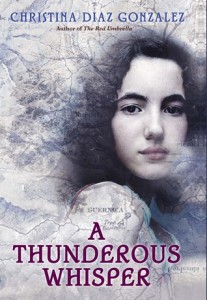In her debut novel, The Red Umbrella (Knopf, 2010), Christina Díaz González mined her rich family history to tell the story of a 14-year-old girl sent with her younger brother to a refugee camp and then to a foster family in Nebraska to save them from indoctrination in Communist Cuba. The program that brought Díaz González’s own mother to the United States from Cuba in the early 1960s, Operation Pedro Pan, comes alive in the hands of this skilled writer.
 Díaz González’s second novel, A Thunderous Whisper (Knopf, 2012), explores the world of her grandparents and great-grandparents, who came to the Americas from the Basque region of Spain. Drawing from their lives and culture, she weaves an original and powerful story of a 12-year-old girl caught up in the Spanish Civil War (1936-1939) and the bombing in 1937 of her town, Guernica, by Nazi forces allied with General Francisco Franco’s Fascist army.
Díaz González’s second novel, A Thunderous Whisper (Knopf, 2012), explores the world of her grandparents and great-grandparents, who came to the Americas from the Basque region of Spain. Drawing from their lives and culture, she weaves an original and powerful story of a 12-year-old girl caught up in the Spanish Civil War (1936-1939) and the bombing in 1937 of her town, Guernica, by Nazi forces allied with General Francisco Franco’s Fascist army.
Anetxu is known as Sardine Girl by her classmates, who bully her relentlessly because she is poor and smells of the fish that she and her mother sell in the marketplace and deliver door to door. At home, things aren’t much better. Her mother still mourns the death of Ani’s brother years earlier. Ani endures both physical and emotional abuse from a mother who won’t call her by her given name but merely “neska”—the word for “girl” in the Basque language—and she misses her father, who has volunteered to fight against the Fascists.
One afternoon, while sitting under her favorite tree outside the city, Ani sees a slightly older boy with a limp. She has never seen him before, and she learns that he has recently moved to Guernica because his father manages movie theaters for a large company. Mathias’s father is of Basque heritage, and his mother is a German Jew; for that reason, he too supports the anti-Fascist cause. After some mutual distrust, Ani and Mathias become friends. He brings her to his father’s theater, where they eavesdrop on his father and other community leaders who have become spies. Soon, the children are carrying messages to the anti-Fascist resistance about the location of Franco’s ground forces and Hitler’s planes and ships. However, they are unable to protect their city against the devastating bombing that destroyed Guernica and killed hundreds of residents.
Many young people learn about Guernica from the famous anti-war painting by Pablo Picasso. Díaz González’s novel portrays the people in a way that contributes greatly to our understanding of the painting, of the war that has widely been seen as an Axis testing ground for the Second World War, and of the lives of children living in a war zone. The author realistically depicts life on the home front and the longing of many children to become part of the fight and to “make a difference” with little understanding of the true costs and horrors of war.